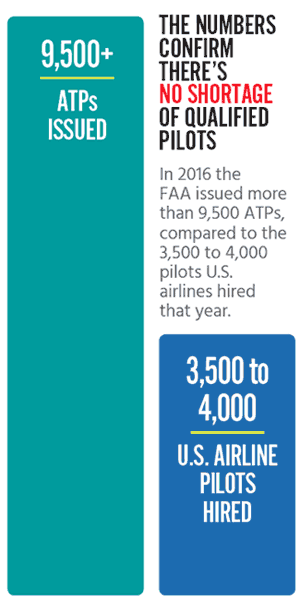First Officer Qualification Regulations Must Not Be Eroded
ALPA: Safety Can’t Be Negotiated
By ALPA Staff
For the last few years, ALPA has had to fight off an effort to roll back safety regulations from some U.S. airlines and special-interest groups. Misusing an economic argument to influence a safety regulation, this collective group has claimed that canceled flights, dropped routes, service cuts to rural communities, and even filing for bankruptcy protection are the direct result of increased safety regulations put into place August 2013. These regulations require that all airline first officers meet higher qualifications—including past flight experience—than those that were previously in place for decades.
It’s interesting to note that these same airlines and organizations that are now attempting to roll back safety regulations initially supported the regulation changes put forth in the Airline Safety and Federal Aviation Administration Extension Act of 2010. However, instead of focusing on needed changes to fundamental issues associated with their business models (their inability to find pilots has to do with substandard wages, a grueling work-life balance, and uncertain career advancements), airlines and special-interest groups fixated on airline profits want to weaken these standards that they claim have created a pilot shortage. Yet no reliable data exist to support these positions. In fact, the data prove just the opposite.
A robust pilot pipeline exists
According to the U.S. Government Accountability Office, there’s an adequate supply of current qualified pilots and a robust pipeline of pilots to meet future airline industry needs. The agency noted that in 2016 the FAA issued more than 9,500 ATP certificates, which includes more than 2,100 R-ATP certificates. “In 2016, U.S. airlines hired between 3,500 and 4,000 pilots, which is considerably fewer than the number of pilots who were qualified to fly for airlines that year,” commented the Association.
Flight-training enrollment is on the rise
Student enrollment at several accredited universities with flight training programs is significantly higher this year compared to last year. Students enrolled at these accredited aviation colleges and universities are taking advantage of the R-ATP pathway to become airline pilots. After completing a two- or four-year university degree program, these students are accumulating 12–18 months of flying experience as flight instructors and corporate, cargo, or charter pilots before progressing to airline flying. The hours and experience garnered in these commercial flight environments are essential to becoming well-trained, experienced, and fully qualified airline pilots.
The safety record
ALPA has underscored that the regulations passed in the Airline Safety and Federal Aviation Administration Extension Act of 2010 to improve training and update certificate type-rating requirements have vastly contributed to advancing airline safety. “Flying experience enables pilots to learn how to gather information through their senses about their environment and their aircraft,” said Capt. Tim Canoll, ALPA’s president, during recent testimony before the Aviation Subcommittee of the U.S. House of Representatives Committee on Transportation and Infrastructure. He observed that these real-world experiences can’t be simulated, noting that an airline pilot could encounter unexpected turbulence or dynamically changing weather conditions, multiple flights simultaneously communicating on the radio, and an engine malfunction all at the same time. “Today’s simulators, while good at training procedures and system operations, can’t replicate the complexity of airline flight,” Canoll remarked.
ALPA’s president affirmed that the best and most important safety feature of any airline operation is a well-trained, fully qualified, and highly experienced professional flightcrew member. The safety record speaks for itself—since the training and qualifications requirements were changed in 2010, there has not been a single pilot training-related fatality on U.S. passenger airlines.
Profitability determines airline service
Where airlines choose to operate is driven by several variables, including passenger demand, appropriately sized aircraft in their fleets, economic incentives, and access to terminal space and ground services and equipment. Like any other business, airlines must decide where they’re able to profitably provide air transportation. Airlines change service levels to airports on a regular basis. As just one example, late last year Southwest Airlines announced that it would end service to Flint, Mich. In announcing the change in service, the airline was clear about its reason: the airport wasn’t a good business fit. It comes down to one basic fact: airlines make operational decisions based on the profitability of each route.
Some airlines and local airport officials, however, are incorrectly attributing a lack of air service to a shortage of pilots. ALPA has reiterated time and again that “safety regulations shouldn’t be driven by the economic goals of airlines,” noting that some carriers believe that safety can be negotiated.
Through ALPA’s education and outreach on Capitol Hill, the Association is correcting this misconception and is also proactively working with Members of Congress to find solutions to maintain air service to these small communities.
“Rolling back first officer qualification regulations and pilot training requirements to fix business-related problems and increase profits is not acceptable,” asserted Canoll. “ALPA will continue to defend against any actions that could erode these life-saving airline safety standards.”

